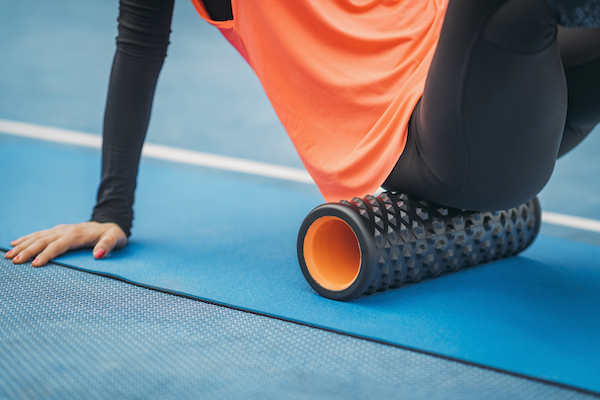What Is Fascia? Learn Why This Connective Tissue Is So Important

If you’ve spent any time in the fitness world, you’ve undoubtedly heard of fascia. Usually, it’s within the same breath as words like “tightness,” “rolling,” and “releasing.”
Here’s what you need to know about fascia.
What Is Fascia?
Fascia is an intricate matrix of collagen fibers that acts like “a full-body wetsuit that wraps around your entire body, as well as every individual muscle within it,” says Lauren Roxburgh, a board-certified structural integration practitioner.
Fascia is critical to connecting the body into a single cohesive unit.
Even within each muscle, there are multiple fascial layers, wrapping around each muscle, the hundreds to thousands of muscle fiber bundles within them, and within each bundle, every individual muscle cell, per recent research.
What Does Fascia Do?

Fascia gives each muscles — and the entire body — its shape. It contains nerves that relay information back and forth to your brain, and blood, oxygen, and other nutrients and waste products constantly flow through it, Roxburgh says.
Then, connecting to other connective tissues and structures like bones within your body, it plays a role in everything you do.
A Frontiers in Physiology study even found that fascia actively contracts and may work similarly to your muscles to power movement.
Whenever you work your butt muscles, arm muscles, or chest muscles, your fascia is hard at work, too.
What Is Fascial Pain?
Unfortunately, your body’s fascia isn’t only working when you’re moving. It’s also supporting your body during the hours you spend hunched in front of a computer, looking down at your phone, or in other less-than-ideal body postures, says Roxburgh.
She explains that the fascia can become almost “stuck” in these shortened, tensed-up positions.
In fact, a 2014 review published in the Journal of Multidisciplinary Healthcare explains that the fascia is soaked in a gelatinous substance that helps each layer easily slide against each other, as well as over the muscles, bones, connective tissues, and other structures of the body.
Inflammation, dehydration, scar tissue, and sedentary activities can all make it harder for the fascia to slide.The result: tight fascia and fascial pain.
What Are the Symptoms of Tight Fascia?
According to Roxburgh, most people with tight fascia often experience the following symptoms:
- “Knots”
- Muscle tightness
- Tension
- Pain
- Limited mobility
Some people may notice that one side of their body isn’t moving quite as well as the other. Maybe they can’t raise one arm quite as high as the other above their head.
Authors of that 2014 review noted that the tightness many people feel first thing in the morning as they get out of bed is actually due to fascia that isn’t sliding properly.
How Do You Improve Fascial Health?

Anyone trying to live a healthy, well-balanced lifestyle should prioritize their fascia, says Roxburgh, who likens fascial care to basic hygiene measures like tooth brushing and showering.
Small actions, performed consistently, can drastically improve your fascial health — and with it, your mobility, fitness, and quality of life.
1. Drink more water
You know that gelatinous substance we talked about before? The one that allows your fascial layers to properly slide and move? To keep your levels where they need to be, hydration is key, Roxburgh says.
Drinking half your body weight in ounces per day can help prevent dehydration, and make sure to add extra fluids when you’re exercising.
2. Roll out your fascia
When you foam roll, you’re not just hitting your muscles, you’re actively wringing out the fascia that surrounds them, Roxburgh says.
That may facilitate the exchange of metabolic byproducts for nutrient-rich blood within the connective tissue.
When rolling, she suggests opting for a lighter-density roller. After all, if the density and intensity are too much, you’ll spend your roll time tensed up, defeating the point of your bodywork.
3. Stretch dynamically
Static, bend-and-hold stretches can feel great and help relieve tension. But, when it comes to promoting fascial function, Roxburgh recommends focusing on flowing, dynamic stretches.
One of her favorites: cat-cow. Take care to deeply inhale through your nose into cat, and exhale through your mouth into cow, she says.
This deep, diaphragmatic breathing activates the parasympathetic, “rest and digest” nervous system while also dynamically stretching the fascia of the muscles that control breathing.
4. Integrate more (non-exercise) activity
All structured exercise and fascial work aside, maintaining a regular movement habit is critical.
It benefits fascial health and function while also helping to prevent fascial tightness and accompanying knots, Roxburgh says.
Be conscious to prioritize active living — walking more, breaking up periods spent sitting, and moving your entire body through a full range of motion. Every bit of movement counts.
